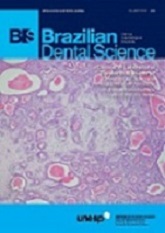Microtensile bond strength to Er:YAG laser pretreated dentin
DOI:
https://doi.org/10.14295/bds.2014.v17i1.954Abstract
Objective: Although the effects of Er:YAG (erbium:yttrium aluminium garnet) laser on cavity preparation as well as on dentin bonding to composite have been described in the literature, the longevity of this bond is still unknown. So, this study evaluated the short-term microtensile bond strength to dentin samples after different protocols of surface treatment. Materials and Methods: 60 bovine incisors were cleaned, worn to expose a dentin area and subdivided into groups according to treatment conditions: surface treatment (no irradiation – control group; dentin irradiation with Er:YAG laser 250 mJ/4 Hz; 160 mJ/10 Hz), adhesive system (Clearfil SE Bond - Kuraray; Adper Single Bond 2 - 3M/ESPE), and storage time (24 h; 90 days). After adhesive procedures, a block of Z250 composite resin (3M/ESPE) was built-up on each tooth. The teeth were sectioned to obtain samples for the microtensile bond strength test. Half of the samples were tested 24 h after cutting, and the other half were stored in distilled water for 90 days before testing. Intergroup analysis was also performed considering the same variables using ANOVA for multiple comparisons with Tukey test with a significance level of 5%. Data showed weaker bond strength for groups previously treated with laser (p < 0.05) compared with control groups, and these were not influenced by adhesive system used, nor by storage period. Stereoscopic microscope observations showed that fractures occurred predominantly at the adhesive interface in the groups irradiated with the Er:YAG laser. Conclusion: Within the parameters and variables used in this study, the Er:YAG laser could not provide an additional improvement in dentin-resin bond strength, irrespective of the type of adhesive system used or the storage period evaluated.
KEYWORDS
Adhesive systems; Er:YAG laser; Microtensile bond
strength.
Downloads
Downloads
Published
How to Cite
Issue
Section
License
Brazilian Dental Science uses the Creative Commons (CC-BY 4.0) license, thus preserving the integrity of articles in an open access environment. The journal allows the author to retain publishing rights without restrictions.
=================




























